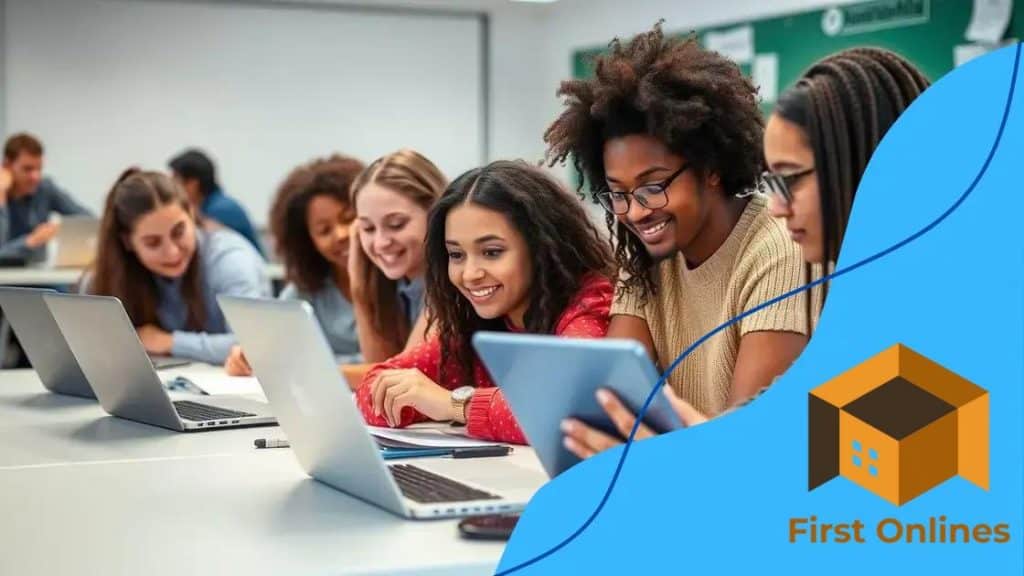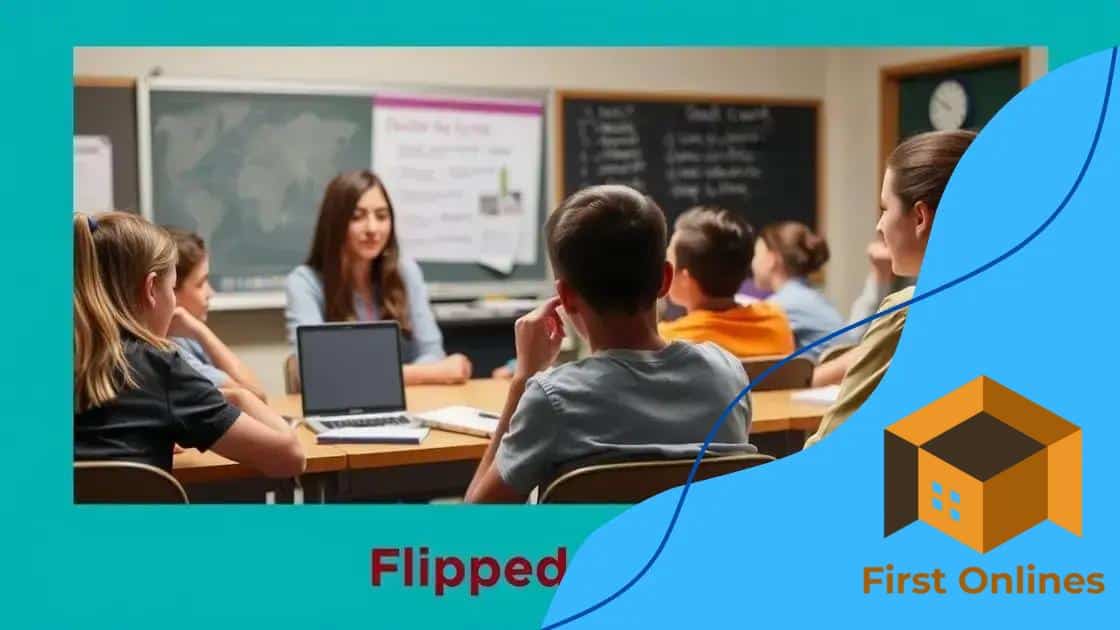How the “flipped classroom” model is evolving in 2025

Anúncios
The “flipped classroom” model is an innovative educational approach where students learn at home and engage in interactive, practical activities in class, enhancing collaboration and personalized learning.
In 2025, the flipped classroom model is evolving, reshaping how we think about education. Have you ever wondered how this approach affects student engagement and learning outcomes? Let’s dive in!
Anúncios
Understanding the flipped classroom model
The flipped classroom model is changing how teachers and students interact in learning environments. Instead of traditional lectures, students engage with course materials at home and participate in hands-on activities in class. This method encourages deeper understanding and active learning.
Key Principles of the Flipped Classroom
At the core of the flipped classroom are a few essential principles that guide its structure:
- Student-Centered Learning: Students take control of their learning process.
- Active Engagement: Class time is used for collaboration and practical applications.
- Accessibility: Course materials are available online, making it easier for students to learn at their own pace.
By focusing on these principles, educators can foster a more interactive and meaningful classroom experience. In this model, technology plays a crucial role. Teachers often use videos or interactive content to help students learn at home. Then, in the classroom, they can work on exercises that reinforce the material.
Anúncios
How Does It Work?
Essentially, the flipped classroom flips the traditional model. At home, students might watch a lecture or complete readings. This preparation allows to come to class ready to dive into discussions or group projects. The teacher’s role shifts to that of a facilitator, guiding students through activities and providing support.
This shift enhances critical thinking because students are not just passively absorbing information; they are actively applying what they have learned. For example, in a science class, students might conduct experiments during class time after learning about concepts at home.
Such an approach not only makes learning more engaging but also allows teachers to address individual student needs more effectively. By understanding where students struggle, they can tailor the classroom experience accordingly.
In the future, the flipped classroom model is expected to evolve even further. With advancements in technology, the ways in which content is delivered and interacted with will continue to change, making classrooms more dynamic and responsive to student needs.
Key benefits of the flipped classroom in 2025

The flipped classroom offers several benefits for students and teachers alike, especially as we move towards 2025. One of the most significant advantages is the emphasis on active learning. This method allows students to engage with materials at their own pace, leading to better understanding and retention.
Promoting Student Engagement
In a flipped classroom, students are more involved in their learning. They can ask questions and participate in discussions, making lessons much more interactive. This approach fosters a sense of responsibility, encouraging students to take charge of their education.
- Increased Collaboration: Students often work together in problem-solving activities.
- Immediate Feedback: Teachers can provide real-time assistance during class activities.
- Personalized Learning: Each student can learn at their own speed, helping them master concepts.
Another crucial benefit is the flexibility it provides. With access to online materials, students can revisit lectures or study difficult concepts as needed. This accessibility ensures that all learners can succeed, regardless of their learning style or pace. As home activities are focused on content absorption, class time is reserved for interactive learning.
Enhancing Critical Thinking Skills
Additionally, the flipped classroom promotes critical thinking skills. Students are not just memorizing facts; they are applying knowledge in practical settings. For instance, in a math class, they might work on challenging problems together rather than simply receiving instruction.
This model encourages deeper analysis and comprehension. When students encounter difficulties, they can explore solutions collaboratively, enhancing their problem-solving abilities. Educators also find it easier to monitor progress and adjust their teaching methods based on real-time observations.
As we look forward, the benefits of the flipped classroom will likely expand with advancements in technology. Innovative tools can further improve the learning experience, making classrooms more engaging and effective for future students.
Technological tools supporting the flipped classroom
In the flipped classroom model, technology plays a vital role. Various tools help facilitate learning, making it more interactive and engaging for students. With the right resources, teachers can create a dynamic educational environment that enhances student learning.
Essential Technology Tools
Many technological tools are available to support this innovative teaching method. Here are a few examples:
- Learning Management Systems (LMS): Platforms like Canvas or Google Classroom help organize course materials and provide an easy way for students to access content.
- Video Creation Tools: Applications such as Screencast-O-Matic or Edpuzzle enable teachers to create engaging video lessons that students can view at their convenience.
- Interactive Collaboration Tools: Tools like Padlet and Kahoot! allow students to collaborate and engage in real-time activities.
- Assessment Tools: Quizzes and polls via platforms like Quizizz or Mentimeter can gauge student understanding quickly and efficiently.
These tools not only enhance the learning experience but also promote collaboration among students. In a flipped classroom, students can work together on projects and share insights, leading to a richer understanding of the material.
Accessibility and Engagement
Moreover, technology increases accessibility. With online resources available 24/7, students can learn whenever and wherever they want. This flexibility is essential for accommodating diverse learning styles and schedules.
Furthermore, teachers can track student progress through analytics provided by digital platforms. This feature allows them to identify areas where students may need additional support, tailoring their teaching approaches accordingly. The integration of technological tools in the flipped classroom is a game changer.
As the flipped classroom continues to evolve, new technological advancements will provide even more opportunities for enhancing student learning experiences. With the right tools, teachers can create an enriched educational journey that prepares students for the future.
Challenges educators face with this model

While the flipped classroom model offers many benefits, it also comes with challenges for educators. Teachers must adapt to new teaching methods and manage student expectations in this innovative environment. Understanding these challenges is essential for successful implementation.
Adapting to New Teaching Methods
One of the primary challenges is the shift in teaching style. Educators must become facilitators rather than traditional lecturers. This change can be daunting, especially for those who have taught in a conventional way for years. Developing the skills to engage students actively during class time is crucial.
- Time Management: Teachers may struggle to balance preparing engaging materials for home with their in-class responsibilities.
- Creating Quality Content: Producing effective video lectures and resources takes time and effort.
- Learning Technology: Not all educators are comfortable with the technology used in the flipped classroom.
Another significant challenge is ensuring that all students are prepared for classroom activities. Educators rely on students to complete assigned materials before coming to class, which can lead to discrepancies in understanding among students. Some may not have the discipline to complete pre-class work, impacting group dynamics and class discussions.
Student Engagement and Accountability
Additionally, keeping students engaged remains a hurdle. In a flipped classroom, students might be tempted to skip assignments since they are not physically present in lectures. This lack of accountability can decrease overall student participation. Teachers must find creative ways to motivate students to complete their work.
Moreover, some students might struggle with technology access or internet connectivity, which can hinder their ability to engage with course materials. These barriers can create inequality among students, further complicating the learning experience.
Finally, it’s vital for educators to gather feedback continuously. Analyzing student performance can help identify gaps and areas for improvement. By addressing these challenges, teachers can make the flipped classroom approach more effective and inclusive for all students.
Future trends in classroom methodologies
The future of classroom methodologies is evolving rapidly, influenced by advances in technology and changing educational needs. As we look ahead, several trends are emerging that will shape how teaching and learning occur in classrooms. These trends aim to enhance student engagement and facilitate personalized learning experiences.
Increased Use of Technology
One significant trend is the increased use of technology. Classrooms are becoming more digital. Smart boards, mobile devices, and virtual reality tools are entering education, making lessons more interactive. This technology helps students explore subjects in a hands-on way.
- Blended Learning: This approach combines online and face-to-face learning, allowing for flexibility and diverse learning experiences.
- Gamification: By incorporating game elements into lessons, educators can motivate students and make learning more enjoyable.
- Virtual and Augmented Reality: These tools provide immersive experiences, enabling students to engage with the material like never before.
Another trend is a shift towards more personalized learning. Educators recognize that each student learns differently. Therefore, classrooms are being designed to cater to individual needs. By leveraging data on student performance, teachers can tailor their approaches to suit different learning styles.
Collaboration and Social Learning
Additionally, collaboration and social learning are becoming essential components of modern education. Students are encouraged to work together on projects, enhancing their communication and teamwork skills. This cooperative learning fosters deeper understanding as students can learn from one another.
The role of the teacher is changing as well. Teachers are transitioning into facilitators who guide discussions rather than the sole source of information. This change allows students to take an active role in their learning process, promoting critical thinking and independence.
As we look toward the future, the trends in classroom methodologies suggest a more interactive, personalized, and collaborative learning environment. With technology at the forefront, educators can create dynamic classrooms that prepare students for the challenges of the future.
FAQ – Frequently Asked Questions about the Flipped Classroom Model
What is the flipped classroom model?
The flipped classroom model is an educational approach where students learn content at home and engage in hands-on activities in class.
What are the benefits of the flipped classroom?
Benefits include increased student engagement, personalized learning experiences, and a greater emphasis on collaboration and critical thinking.
What technological tools support the flipped classroom?
Tools like learning management systems, video creation software, and interactive collaboration apps help enhance the learning experience.
What challenges do educators face with this model?
Challenges include adapting to new teaching methods, ensuring student accountability, and managing varying levels of technology access.





